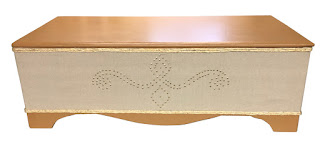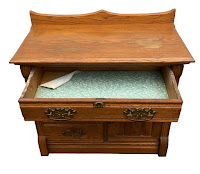 |
| Stendig Chair Before |
 |
| Stendig Chair After |
As of this writing, I can truthfully say that these chairs have been the most difficult caning project to date. Jim took them apart and worked on the refinishing. Once that was done, I started the tedious process of caning each of the eight sections (two per chair) of these unique mid-century pieces.
 |
| Photo 1 - Channels that hide back of cane |
 |
| Photo 2 Top front of chair before cane removal |
I had done many caned chairs prior to these, but never had I expected the challenge this style of chair would present, not only in the refinishing, which required them to be taken apart, but removing the channels (see photo 1) that covered up the caning on the back of the chair and were glued in place. How do I remove them to access the caning without damaging the chair?? I researched it, but could find no information of how to achieve the removal of these channels, which meant there was only one solution. I had to figure it out myself, so that’s exactly what I did. I snipped off the sheets of caning from all backs, (see photo 2) leaving only the front edging (see photo 3) before I devised a way to remove the channel. For the seats, this was much easier because there was no channel to cover them, so I was able to remove the cane in its entirety, as I had done with many previous cane chairs in the past.
I realized that since the channels were glued in place, I would have to find a way to dissolve the glue so I could gently pry them apart from the chair’s curved border in order to remove it, which would expose the original cane beneath. But how to do that...carefully. Well, a bit if creative thinking and the right tools solved the problem. I figured if I could get to the inside of the holes and gently tap them, I could loosen the channel enough to remove it. The only problem was, since the channel was glued, this would likely break the channel as well as the chair in that area, so there had to be an additional step.
 |
| Photo 3 Top of chair border only remaining |
 |
| Photo 4 Using eyedropper filled with lacquer thinner to loosen glue on front side of channel |
Once I was assured that I had enough lacquer thinner in each hole, I gently tapped each hole with another, duller awl (see photo 5) so as not to damage the exterior of the curve or the channel. After a lot of dropping, tapping and more lacquer thinner, eventually the channel loosened enough for me to remove it, exposing the caning beneath (see photo 6). Then, finally, I used a drill to clean out the remaining bits of old cane so that the holes would be free of debris to better accept the new cane (see photo 7).
 |
| Photo 5 Using a dull awl to gently pound thru holes that pried channel away |
 |
| Photo 6 Channel removed, exposing original cane tie-off on back top of chair |
 |
| Photo 7 Drilling holes to clean out old cane |
 |
| Photo 9 First Weave |
\ |
| Photo 8 Steps 1-3 tied together |
I soon learned that it was impossible to keep the rows straight in a curved chair back, so I “went with the flow” and allowed the chair to evolve as it was woven, and indeed, it wasn’t half bad. Each chair back that followed I go a little bit more confident and found a few more tricks to keep the vertical and horizontal rows aligned so that they were easier to work with. This also made the 5th and 6th steps, the diagonal weaves, flow much better. Photo 10 shows the last diagonal weave going to the upper left corner. The last and final step was binding the cane with a border binding cane that finishes off the top. Then the tie-off finishes the bottom. Many steps with a lot of work and time involved in these chairs, so I enlisted my granddaughter’s help by teaching her a new skill which she learned very quickly.
 |
| Photo 10 Last Diagonal Weave |
 |
| My helper |
 |
| My cat, Chelsea keeps me company |
 |
| Chairs in customer’s home |

































